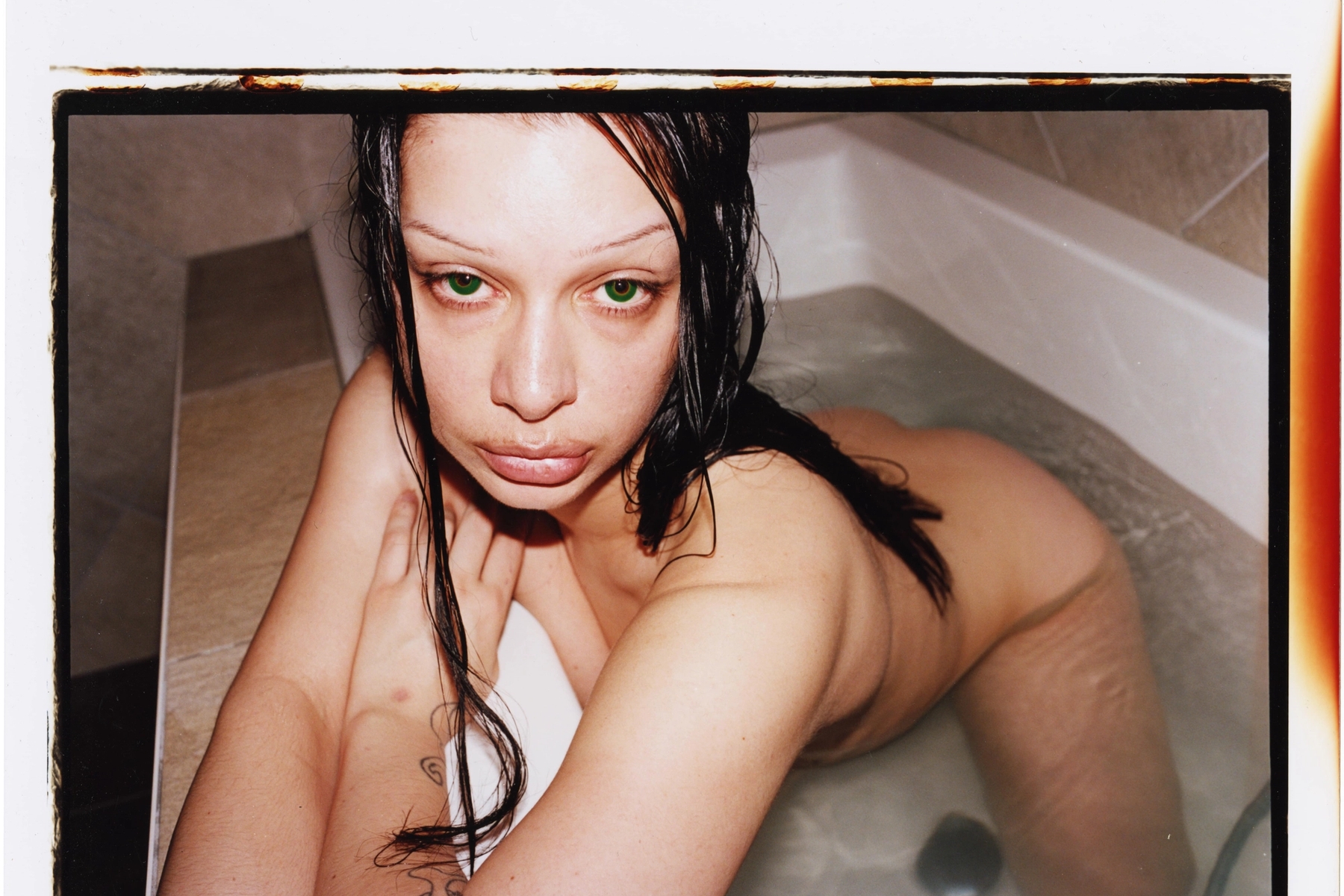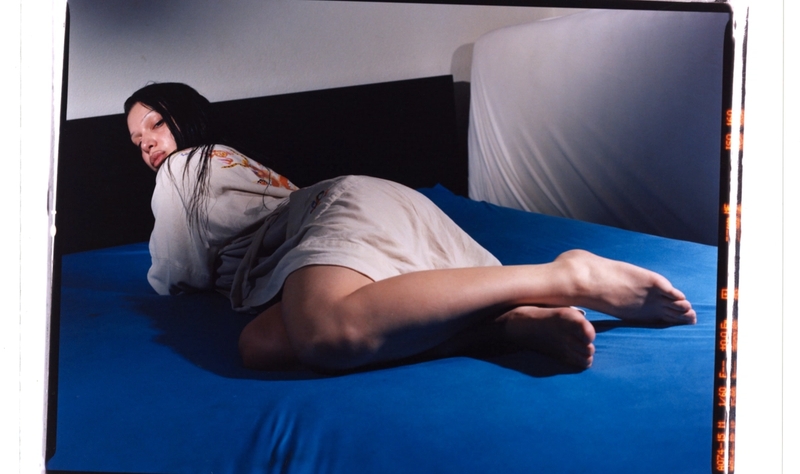Mercatoria’s Felt Cuts: Pe Ferreira & Azize Ferizi
Header image: Azize in her guest bed, 2023. C-print. 20 x 25 cm (8 x 10 in). Edition 1 of 3. © Pe Ferreira
Earlier this spring, Paris-based polymath artist Pe Ferreira unveiled a new series of photographs at Mercatoria Fishing Club in Saint Leonards-on-Sea, UK — a new exhibition space and home, programmed and inhabited by Dan Demarre (..thth..).
In this exhibition Sao Paolo-born Ferreira (b 1996) was paired with British post-photorealist painter Paul Roberts (b. 1948), part of a wider program of duo shows intertwining contemporary art with site-specific storytelling. This exhibition marked the inaugural event in a space both coastal and conceptual: anchored in practice, yet unmoored in structure.
Hanging above a black Shellbourne radiator in on a terracotta wall is a large format portrait — a figure looking to camera, laid on a leather sofa wearing tights that read “DRAMA” and “POWER” on each limb.
Ferreira made this striking portrait of her longtime collaborator and friend Azize Ferizi. The Swiss-Kosovan painter known for her textured portrayals of the human form, recently had her own solo exhibition in Friart Fribourg. Their dialogue, intimate banter moderated remotely, dives deep into the overlapping zones of friendship, fatigue, and freedom.

Novembre: Let's begin with the notion of nonchalance. Do you identify with that concept in your work — or in your life?
Pe Ferreira: I had to sit with that word. I think of it less as indifference and more as blind momentum — like an arrow mid-flight. You're already launched, you don't know if you'll hit the mark, but you're moving. That's what making feels like. Sometimes it's obsessive, even destructive. But it carries you.
Azize Ferizi: It's different for me. I studied visual arts at HEAD Geneva, and during school, nonchalance was almost built in: you had time, space — no urgency. But when you leave that bubble and confront the market, the pressure builds. It helps to have other sources of income to support my practice, to resist that constant push to produce. Because if I produce just to keep up, I lose something essential. I lose honesty.
Novembre: Pe, your portraits seem almost too intimate for the term "nonchalant." There's real tension. Are you witnessing, or directing?
Pe Ferreira: Neither. Or both? I don't stage things. There's no script. I aim to reach that edge: just before I become the person I'm photographing. It's like standing right outside their skin. I try to dissolve the boundary between us, but without fully crossing it. That space, that near-collapse, is the image.

Azize Ferizi: I experience something similar, but more inward. I don't paint real people. I'm looking for gestures, a kind of bodily memory. It's intuitive, abstract. But I also only paint female bodies — because that's what I relate to. I tried painting men, and it felt ... wrong. Like it wasn't mine to do.
Novembre: That kind of proximity — emotional, artistic — can be draining. Do you ever feel fatigued from the intimacy your work demands?
Pe Ferreira: Not tired exactly. But it can hurt. My work is tied to real relationships: friends, lovers. If something shifts there, the whole structure shakes. And I'm not interested in output for its own sake. I can go days carrying a camera and not take a single photo. Sometimes I just look. Wait.
Azize Ferizi: Yes. We have to make space for that kind of slowness or wandering around to process thoughts and emotions. I sometimes feel I have to fight against the expectation to be constantly visible, constantly prolific. But I'd rather make less and feel more. Otherwise, what's the point?
Novembre: How has your definition of success changed since you first started making art?
Azize Ferizi: It depends on the goal you set for yourself when you enter this environment. Lately, I feel most successful when collaborating feels easy and motivating — whether with a team, an institution, a gallery, or other artists. I guess that comes with being more comfortable in my work, but also with having a supportive team.
Pe Ferreira: "Success is often a tunnel without an end, and the light at the end flickers." I needed to leave that metaphor behind — so sometimes I do, I leave it behind. It catches up to me if I look back with fear and doubt too much. Success, to me, is beating that cowardice with all your might.
I'm talking about the attempt alone, not necessarily the "happy ending" — which is the defeat or conquest of fright. If all my might is unable to beat it, which is often the case — I won't lie — then success can simply be a succession. One day after another simple day. Little by little, something, And at times, nothing.

Novembre: Do you think art can heal? Or does it simply expose wounds?
Azize Ferizi: I go to therapy to heal. [laughs] I don't ask that from my practice. That said, translating something painful into work can make you feel less alone. And sharing that — finding out others feel the same — that is a kind of healing. But I try not to rely on art for it.
Pe Ferreira: I agree. The work isn't therapy. But it's a form of expression that channels something inward into something outward. That shift can create balance. And maybe someone who sees the work will feel something they didn't have words for. That's where the power lies — not in curing, but in connecting.
Novembre: Do you think isolation is necessary for certain parts of your practice, or do you need connection at every stage?
Azize Ferizi: I've found a balance now where I need to be surrounded by a lot of mess, noise, events — and behave like a sponge in that moment. Then I go into isolate-mode to figure out and process all of that big mess. But definitely, when producing, I need to be alone. It can be intense at times, but I think that's also what I like.
Pe Ferreira: I do need to be alone in complete darkness to enlarge my photographs. That I take time (mine, and others') is essential to my practice.

Real connection doesn't evaporate with distance.
I want to say that I gravitate towards solitude to seek clarity, to fix dead ends and observe blind spots, more and more. But that's a lie. I wouldn't really mind being in other people's presence all the time. I transform in the process of sharing, and I do like change. And I can't say I do either of those exclusively.
Novembre: Do you feel a responsibility (to yourself, to your audience) in making work?
Azize Ferizi: Lately, I've thought about that a lot. The only real responsibility I've found is to be honest. That's harder than it sounds. You're surrounded by noise: expectations, success metrics, trends. But honesty is what moves people. When I feel it in someone else's work, it stays with me.
Pe Ferreira: Yes. Honesty. And clarity. Not every piece has to be profound or heavy. But it should be true. If I'm responsible for anything, it's to remain open — to not fall into patterns that dilute the core of what I'm doing. And to share, when I'm ready, not because I should, but because I must.

Novembre, to Azize: You talk about honesty — how do you personally recognise when you are being truly honest in a painting? Is there a physical or emotional signal?
Azize Ferizi: It's more about the feeling at the starting point of any new project. In the beginning, I used to think you had to know from the outset what the project would become and represent — and that was wrong for me, dishonest. You become easily disappointed and confused.
A sense of honesty, for me, is letting go of expectations and feeling confident throughout the process.

Novembre, to Pe: How do you feel now, looking at the image of Azize that's in the MFC show?
Pe Ferreira: Azize is shaped into a bent cross on that leather couch — I like that. We were sharing the same living space at the time, I remember cooking and making weird food choices for both of us. Azize rejected some of the ingredients and reproached my couscous, so I told her to face the wall. We looked after a grumpy cat named James, which is also the name of our mutual good friend who housed us for a month in New York City — my first time, Azize's second.
Novembre, to Azize: Same question!
Azize Ferizi: I love seeing a print of my ass this big!
Novembre, to Pe: How come you've decided to make it so large (120 x 150cm)?
Pe Ferreira: It was the second-largest in the show. I love life-size, enormous figures — and it usually takes the dimensions it demands. I have her portrait hung like a poster or billboard and let it sit loudly. Enlarging a photo that big makes me feel very robust — much like a "shower" is — even though by definition the process is that of a grower. Very BDE, in an androgynous, womanly way. It's a great feeling.
**
Mercatoria’s Felt Cuts is a column tracing conversations from Mercatoria Fishing Club, the abode and exhibition space of artist and coastal defector Dan Demarre (..thth..) Stay put for theoretical musings, style advice, and celebrity gossip with the artists involved.


